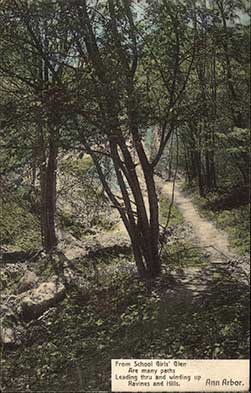
This postcard, mailed in November 1911, describes the glen’s “many paths leading thru and winding up ravines and hills.” Schoolgirls’ Glen may be one reason the homesick writer (an Ohio native) is “getting to like Ann Arbor a little better.”
In the 1800s, the people of Ann Arbor and students at the University liked to walk through a deep, narrow valley that led from the heights near Forest Hill Cemetery down to the Huron River below, at the campus end of the acreage that would eventually become Nichols Arboretum.
Every spring in the 1850s, Miss Mary Clark, the principal of a local private school for girls, would lead her pupils to the little valley to collect and press wildflowers. No one knows for sure, but that may be why people began to call the place Schoolgirls’ Glen.
Born of a glacier
The glen was made eons before it had a name. It was sculpted by a spring-fed rill that cut down through the glacial ridge along the Huron. The tiny stream’s course may have followed the track of great ice blocks that dropped off the glacier and melted to soften the soil. In time the cut grew to 300 feet at its widest point and ran more than 1,000 feet from the heights down to the river.
With slopes too steep for the farmer’s plow, the glen stayed much the same through the years. Strollers of the 19th century praised the views from the heights above and the Huron below.
“No person with any poetry in his soul can walk from the second railroad bridge north to Schoolgirls’ Glen without rhyming all the way,” wrote a U-M student of the 1870s. “We have tried the experiment. It can’t be done. There is no more beautiful bend in any river at any season … and many a homelier and more uninviting place than Schoolgirls’ Glen has been celebrated in song.”
Birders’ paradise
There were shady places and sunny places and a mixture of clay and sand underfoot, so the glen grew an extraordinary mixture of shrubs, ferns, wildflowers, and trees in a tight space. In turn, the rich variety of flowers and trees attracted an exceptionally diverse collection of insects and birds.
Where the rill flowed into the Huron, birdwatchers counted sandpipers, bitterns, kingfishers, ospreys, mergansers, wood ducks, and gulls. Up the slopes, there were thrushes, thrashers, warblers, towhees, vireos, and Baltimore orioles. Near the orchards at the top there were juncos, finches, song sparrows, meadowlarks, indigo buntings, and snow buntings not long from the Arctic.
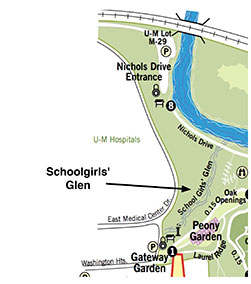 As with the greenery of the glen, it was striking to find so many kinds of birds in one small place.
As with the greenery of the glen, it was striking to find so many kinds of birds in one small place.
It was “a strong demonstration of the disturbing influence of man’s methods,” an Ann Arbor ornithologist named A.D. Tinker wrote in 1908. “These isolated spots throughout the country where nature is allowed to hold forth in something of her normal state form havens of retreat for the birds and if unmolested will in the future be a powerful factor in the preservation of our feathered friends.”
Eventual encroachment
Even in the 19th century, the glen was not untouched by human development. The tracks of the Michigan Central Railroad ran along the south bank of the Huron for years, and sometimes sparks and coals shed by trains touched off fires that spread up through the valley. But the greenery would recover — in fact, the fires cleared space for prairie grasses to thrive — and the birds would return. And when the glen was incorporated with neighboring tracts to form Nichols Arboretum in 1907, it seemed to be saved for good.
In the 1930s, engineering professors urged that the Arb be converted to a winter sports facility, but a committee appointed by President Alexander Ruthven — a zoologist — said no. “It should be kept so that it might become a haven of quiet one hundred years from now,” the committee declared, “when our rich native flora will have become a thing of the past in most places.”
Then, after the Second World War, Schoolgirls’ Glen began to wash away.
The vanishing…
The University was pushing eastward into the glen’s watershed. Orchards and fields where cattle and sheep once had foraged were paved for parking. The soil of Forest Hills Cemetery was by now crowded with concrete vaults. The University’s giant Mary Markley Hall and the School of Public Health were built along Washington Heights. Stormwater from all the new roofs, paved roads, and parking lots was channeled into three big storm drains that emptied into the glen. As a final signature of human encroachment, the thick trunk of Ann Arbor’s sanitary sewer was laid square across the glen’s mouth down at the river, right out in the open.
(Click on the arrows at the side of the frame below to view slides that convey the glen’s changing landscape.)
Sounding the alarm
In the early 2000s, students in the School of Natural Resources and Environment (SNRE) studied what decades of unchecked stormwater had done.
At the base of the glen they found a gulch that looked more like a place in the Rocky Mountains than the upper Midwest. Glacial boulders hidden underground for millennia now sat exposed on the ground, and a wash of rocks and gravel spread out to form a brown delta in the Huron. The finer soils that once had nourished the glen’s flowers were now way down the river, banked up against the dam at the end of Geddes Pond. Invasive buckthorn and honeysuckle crowded the slopes, and birdwatchers had followed the birds to other, more hospitable spots in the Arb.
The students estimated that, on average, at least a cubic yard of soil had washed out of the glen every day for the last 35 years.
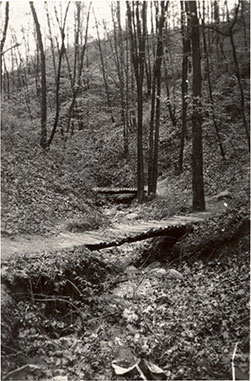
Harlow Olin Whittemore, former director of Nichols Arboretum, photographed this scene in the Arb in 1937, probably in Schoolgirls’ Glen. (Image: Papers of Harlow Olin Whittemore, courtesy of U-M’s Bentley Historical Library.)
Rescue party
The first to sound the alarm had been Liz Elling, a graduate student in SNRE in the early 1990s who joined the Arboretum’s staff. She worked on the problem with Robert Grese, an SNRE professor who became director of the Arboretum in 1999 (and of the Matthaei Botanical Gardens when the two properties were joined in 2004); and Donald Gray, a retired professor of civil and environmental engineering, then president of the Friends of Nichols Arboretum and an expert on erosion control.
These three and others organized efforts to slow the run-off. Stepped pools and bioswales were installed near Washington Heights. Students and volunteers replaced invasive plants with native varieties that do more to anchor the soil. With help from a crew of Ford Motor Co. engineers and a grant from the Great Lakes Commission, a special dam of football-sized boulders was laid across the ravine to slow the flow.
When the new C.S. Mott Children’s Hospital was built, a giant stormwater detention tank was installed under the building. Some, not all, of the new parking lots in the area were constructed with permeable paving, so the rainwater sinks into the ground.
Reclaiming the glen
All of this helped. Erosion in Schoolgirls’ Glen has slowed. But it can never look as it did in the 1800s — too much soil is simply gone — and the three big storm drains still lead to the head of the ravine. The glen canrecover what Grese calls its “ecological integrity,” but only if more is done, and soon.
“It’s still very fragile and vulnerable,” he says. “It’s kind of a secret that no one knows about – just how scenic this land is — or was. It still is, today, if only we could reclaim it.”
Sources include Donald Gray, Robert Grese and Tammy Orlow, “Saving Schoolgirls’ Glen,” Erosion Control, March-April 2004; Steve Gilzow, “Soft Healing at the Arb,” Ann Arbor Observer, February 2009; A.D. Tinker, “The Birds of the Schoolgirls’ Glen Region,” Michigan Geological and Biological Survey (1910); “Ann Arbor,” The Chronicle, vol. 6, no. 7 (January 9, 1875); Alfred Dachnowski, “Contribution to the Botanical Survey of the Huron River Valley,” Michigan Academy of Science (1907).

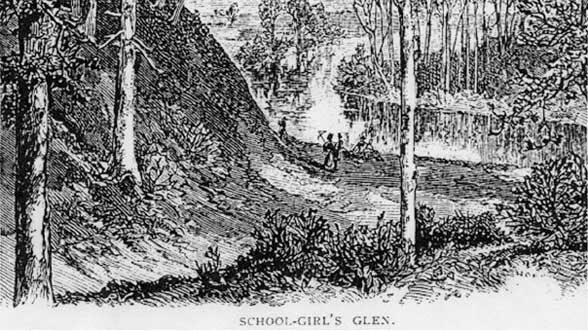

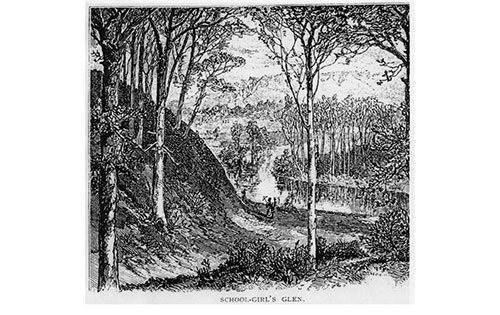
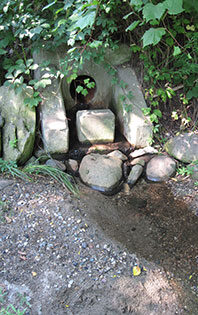
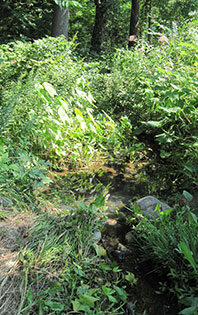

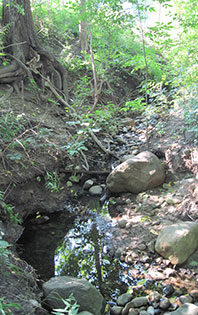
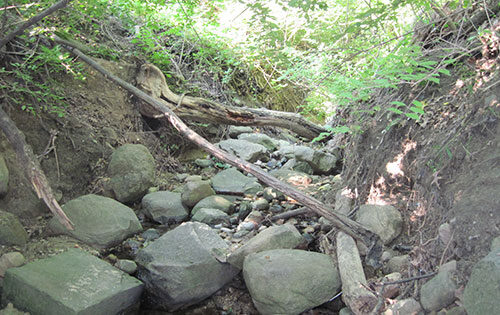
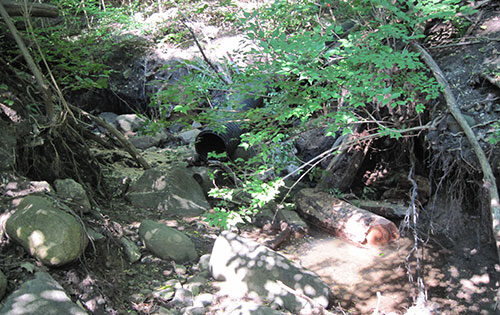
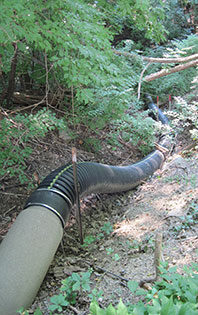
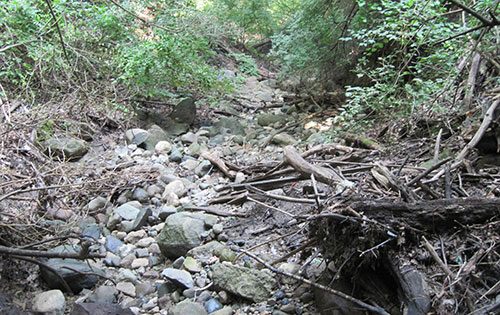
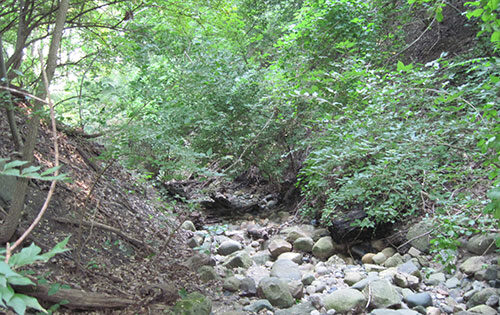
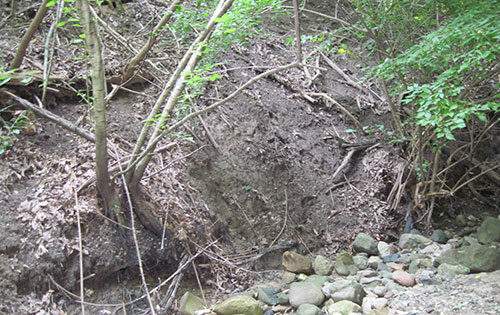



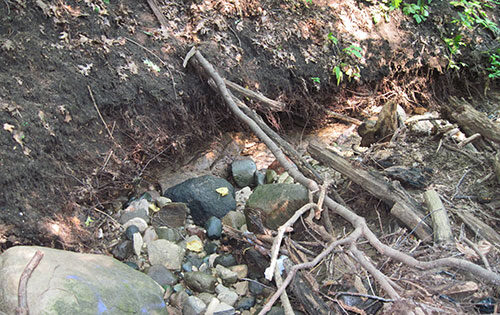
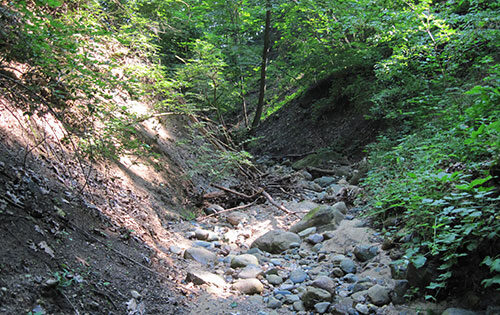
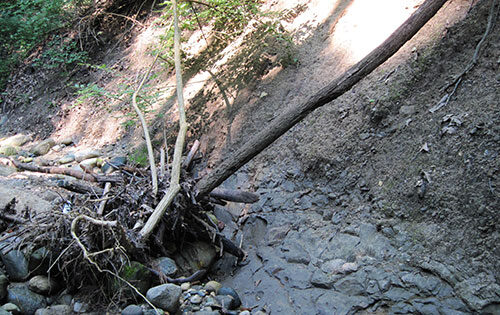
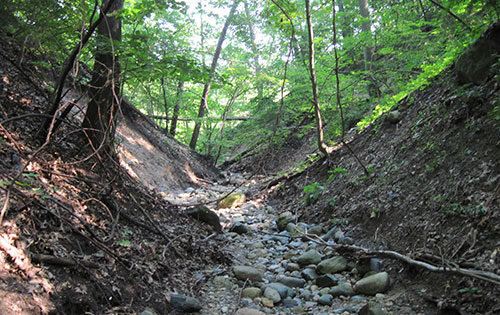
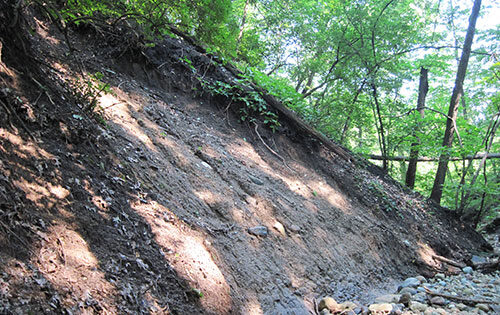
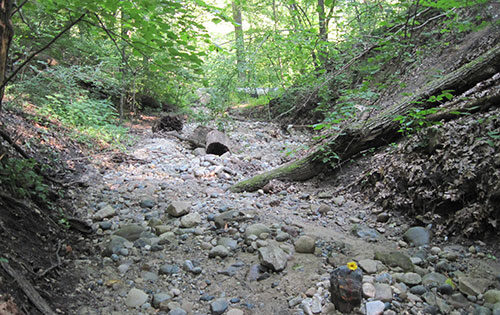


Daphne Benichou - 1992
I think I only skipped class a handful of times in my memorable years at UM, but every time it was so that I could relax and dream in the Arboretum! Thank you for the article and the work to save such a magical place!
Reply
Laura Jarvis - 1982
I suspect midnight winter sledding (w/”borrowed” trays from the dorms) didn’t help the erosion, either. But the Arb was my early morning shortcut from the Art School back to campus once the buses stopped running and its nightime beauty made me return in more “normal” hours!
Reply
John Ormstad - 1990
I can only be saddened to think we cannot reclaim this “great prize” of Ann Arbor. It should remain a fixture of “pride and enlightenment” if the rallying cry can be placed for enjoyment and servitude.
Reply
lewis(Bill) Dickens - 1964
Seeing the Arb in the last several years was a shock. Many fine trees were gone and it looked awfully raggedy.
Looks to me like it is in desperate need of concerned planting and maintenance.
Reply
Sharon Weremiuk - 1964
I have been shocked on return trips in 2003 and later to see how ravaged the Arb is. It was a beautiful place to walk and contemplate nature in the sixties. I hope we do reclaim it. I remember especially the rhododendron grove which appears to be all but gone.
Reply
Mark O'Brien
The rhododendrons are still there in abundance.
Reply
Clare Bismuth - 1957
We borrowed serving trays from the cafeteria & sledded down hills in the Arb, two to a tray.
Reply
Marc Stephens - 1992
Isn’t this glen currently called ‘Troll Hollow’?
Reply
Georgia Hale - 1987
The ‘Arb’ was a wonderful place I loved to walk. I hope to revisit this fall.
Reply
Kathleen Young - 1968
We have to stop thinking of the Arb as a “park”. It is a habitat for unique botanical specimens. Using it for “runs”, “walks” and other fund-raisers and putting it under the umbrella of the Matthaei Botanical Gardens which is constantly looking for ways to get more people to buy memberships is only going to run the Arb down even more. I would like to see the Arb get a well-deserved “rest” from intrusion and some careful planning to recover its beauty, history, and unique importance to the U of M. I was very saddened at the theft of the beautiful and rare peonies awhile back. The Arb and the Matthaei Botanical Gardens–2 very different missions.
Reply
Margaret McLean - 1992 (Law)
Loved the Arb as an oasis from law school stress and bustle. Peonies in the spring is what I remember best.
Reply
Tony Machowski - 1964
The Arb was simply part of my daily life in Ann Arbor for 10+ years — the perfect incubator for U of M’s daily dose of often difficult life lessons. So sad to imagine the Arb ‘less than’ its former self.
Reply
Carolyn Poissant - 1981 (BS - SNRE), 1987 (MLA)
I have repaired many such areas as a park planner working with volunteers in Michigan, Colorado, and Nevada, where “gully-washers” are common. It can be done. Volunteers for Outdoor Colorado (VOC) often tackle extensive restoration projects, especially after the many wildfires and floods out there. Michigan needs its own “VOC.” Maybe I’ll start one.
Reply
Yolanda Gesswein - 1975
This magical place needs to be rescued. If I had a million dollars to donate for such a noble project, I would. There is no price on the memories a place such as this imprints ln ones’ soul.
Reply
Jack Edwartoski - Staff not Graduate (UDM-'72)
James has given us a beautiful, thought-provoking, compelling piece of prose to invite us to seek out this place and to do something about its care and preservation. Thank you!
Reply
Mary Hathaway - 1956
I did not know it was called School-girls’ Glen, but as a school girl I discovered this ravine and liked to go there in my explorations. It felt like a secret place. With a best friend (the two of us wearing pants just like boys) I crept into the opening of a huge storm-water pipe and made it echo. The pipe had a suspicious odor as though something more than rain water had traveled through it.
The Arb was a great place for a twelve-year-old to ramble. The hills and valleys had names. One was and is “The Elephant’s Head.” You can see its knobby cranium and long trunk. At the top of it I once saw a pair of naked students pulling on their clothes. At the bottom of it, from a distance, I watched a wedding ceremony.
During my student years I worked summers at the Children’s Psychiatric Hospital which was then a residential facility. My job was to care for a small band of boys, ages 10 to 12. Favorite activities included wading in the river looking for crayfish, and climbing on a certain fallen but still vigorous willow tree.
I married a townie. One of his boyhood memories was of acting in a play in the second valley. The play was “The Road to Jerusalem; John played the boy Jesus. The grove of evergreen trees at one end of the valley served as dressing rooms and had openings for actors to enter and exit.
Now I take my grandkids to watch Shakespeare in the Arb. Surprisingly to me, they had not experienced this wonderful place before attending the performance of Midsummer Night’s Dream. But I could not imagine a better introduction to the Arb than to find it populated by fairies and ruled by magic.
Reply
Beverly Strassmann - 1975, 1978, 1990
The area of beautiful pines near the entrance to Dow Field was marred by the construction of the shelter/stage. For me it wrecked the natural beauty of this special place. I hope that one day it will be removed by enlightened management and that no other structures are built in the Arb. Those intrusions are more fitting for a park, not an arboretum.
Reply
Brad Marten - 1983
Loved the arb. An amazingly beautiful and peaceful retreat. It would be a shame for future generations of students not to be able to enjoy its’ splendors.
Reply
Julie Lee - 1994
When I return to campus, one of the most significant observations is the loss of space for respite and reflection in all areas, but in particular in those areas that were set aside for conservation by the university’s founders. The Arb has gone from a place where escapism is easily obtained, to a park with a very pedestrian feel. Many previous comments have struck the same cord, and my interpretation is that people need a place to connect with a primordial association to nature, the smell of soil and moss, the noise of leaves, and the birds’ cacophony, even if they’re unconsciously appreciating those senses while contemplating Dr Gray’s mid-term. My friends and I appreciated his classes, and now I know that was because he “walked the walk.” Thanks to all who are working to repair the human footprint, and preserve the natural aesthetic of Schoolgirls’ Glen. Great article!
Reply
Eric Arnold - 1961, 1963
Having grown up in Ann Arbor, the name “School girls’ glen” was familiar from stories my mother had from her days as a graduate student in botany in the late 20’s and early 30’s, but I never learned precisely where it was until a decade or so ago when the interest in restoring it developed. For some reason, my mother had not remembered exactly where along the Huron valley it was, perhaps because the area surrounding that part of the campus and the Arb changed so rapidly from the 40’s onward. I got to know the glen on my own before I learned that it was the location where she had often gone with classes or just with others who appreciated the diversity of the plant and animal life there and the beauty of the area. It was good finally to know where the area was that she had enjoyed so much, and seeing some of the historical pictures of the area helps to understand her particularly fond memories of the glen.
Reply
Carol (Albers) Kalamaras - 1960
I, too, remember the sledding. I used to love to come to campus with my dad around South Lyons and cross over the Huron or cut over Arlington from Washtenaw coming in from the south. Then we would head up to Hill Road where he would drop me off at Alice Lloyd dorm.
When even younger my family would have many wonderful picnics on the island in the middle of the Huron river as a mid point meeting by those from Detroit and us from Dundee.
I would think that the Huron River Watershed Council could be interested in getting something started also. There is quite an effort to protect this important watershed and riparian integrity.
I still own property by Joslin Lake past Chelsea and am part of a biological study to determine habitat preservation. Glad that more are taking note of this whole landscape for the future generations!
Reply
Wystan Stevens - 1970
Nice story, but I have two minor corrections. The cemetery is called Forest Hill, not Hills. And Mary Clark’s Select School for Young Ladies was not on Division Street in the 1850s — it moved there in 1865 (to the NW corner of Kingsley and Division), following a fire that destroyed its previous location.
Reply
Deborah Holdship
Thank you, Wystan. The story has been revised accordingly. — Ed.
Reply
Carolyn Zanta - 1986
I loved taking walks with my friends in the arb when we lived in Markley dormitory. Favorite memories included “traying” during the winter, “studying” in the sun when it got nice in the spring, and attending a beautiful sunrise Easter service.
Reply
Howard Kramer - 77 (BA) 79 (MA) 81(JD)
During my 7 1/2 years at UM, I went to the Arb about 150 times, at least 100 of which were at night. It was the favorite place in A2 for my friends and I. It is a jewel of the city and the University and must be maintained and rejuvenated. Not like it was in the 1800s, but at least the way it was in the 1970s.
Reply
Dave Wolf
I grew up in Ann Arbor and used to go to the Arb often – especially in the winter, as it offered one of the most-terrifying sledding experiences (at least to me, back then) on “Devil’s Dive” – the premier ride for thrill seekers with toboggans and sleds, and hardly sounding like the serenely-named “Schoolgirls’ Glen” that it fed into. It may have actually been pretty tame, but to a kid my age it was a death-defying, heroic challenge that we could boldly boast to our friends about!
I guess it was the sixties’ precursor to “eXtreme” sports.
Loved my life in A2 – I was fortunate to have grown up there, been part of the eclectic international atmosphere, and to have been a part of U of M. Even though I never went to college there, I will always bleed maize and blue.
Reply
K Shea - 1987
It’s too bad that the University did not do strategic long term planning to consider this important place during the expansion at the time- for all who have enjoyed and learned from this free, natural precious gem and for future generations. Maybe they can use funds from the large giving campaign this year to reverse the damage.
Reply
Carrie Bach - 1984
Happily, it is still possible to ‘get lost’ in the Arb and feel that you are a million miles away from humanity. The Botanical Gardens are another valuable treasure. Both have undergone many changes, primarily for the better, and in some cases, the changes have been to reverse earlier damage caused by ill-informed decisions. Environmental management techniques continue to evolve, and from firsthand experience, I can say that the staff at the Gardens and the Arb are truly committed to ensuring the preservation, restoration, and renewal of these special places. They are well aware that the Arb is not just another ‘park’ and the time, thought and effort they put into their stewardship is passionate. I’ve been a volunteer at MBGNA for about 20 years now, and in the last 4-5 years have witnessed significant projects that have greatly enhanced both locations. The energy and enthusiasm of the staff, student interns and other volunteers is palpable. I feel sure that these Ann Arbor treasures are in good hands.
Reply